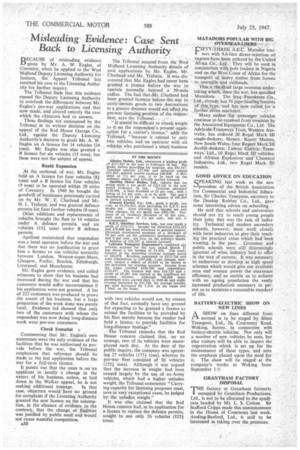Misleading Evidence: Case Sent Back to Licensing Authority B EC AU
Page 32

If you've noticed an error in this article please click here to report it so we can fix it.
SE of misleading evidence given 'by Mr. A. W. Eagles, of Coventry, when he applied to the West Midland Deputy Licensing Authority for licences, the' Appeal Tribunal has remitted his case to the Licensing Authority for further inquiry.
The Tribunal finds that this evidence caused the Deputy Licensing Authority tO overlook the differences between Mr. Eagles's pre-war applications and that now made, and altered entirely the case which the, objectors' had to answer. These findings are announced by the Tribunal in its written decision' on the appeal Of the Red House Garage Co., Ltd., against the Deputy Licensing Authority's' decision to grant Mr. A. W. Eagles an A licence for 14 vehicles (34 tons). Mr. Eagles was also granted a B licence for six vehicles (15 tons), but these were not the subject of appeal.
Rapid Expansion ,
At the outbreak of war, Mr. Eagles held an A licence for four vehicles (8± tons) and a B licence for four vehicles (9 tons) to be operated within 20 miles of Coventry. In 1940 he bought the goodwill of businesses previously carried on by Mr. W. E. Chatland and Mr. H. L Trahern, and was granted defence permits for four further vehicles (8 tons).
Other additions and replacements of vehicles brought the fleet to 14 vehicles under A defence permits, and six vehicles (15f tons) under B defence permits.
Apellant maintained that respondent was a local operator before the war and that there was no justification to grant him a licence to use vehicles normally between London, Weston-super-Mare, Glasgow, Forfar, Brechin, Edinburgh, Liverpool, and Manchester.
Mr. Eagles gave evidence, and called witnesses to show that his business had increased during the war and that his customers would suffer inconvenience if his application were not granted. A list of 222 customers was produced to prove the extent of his business, but a large proportion of the work done was purely local. Evidence led showed that only two of the customers with whom the respondent was now doing long-distance work were pre-war customers.
Check Essential • Commenting that Mr. Eagles's own statements were the only evidence of the facilities that he was authorized to provide before the war, the Tribunal emphasizes that reference should be Made to the last application before the war for a full-term licence.
It .points' out that the onus is on 'an applicant to justify a change in the natureof. his business, unless, as laid down in the Walker appeal, he is not seeking additional tonnage. In that case, objectors would have no ground for complaint if the Licensing Authority granted the new licence on the assumption, in the absence of evidence to the contrary, that the change of facilities was justified by public need and 'would not cause wasteful competition.
A30
The Tribunal secured from the West Midland Licensing Authority details of. past applications by Mr. Eagles, Mr Chatland and Mr. Trahern. It was discovered that Mr. Eagles had never been granted a licence before the war to operate normally., beyond a 50-mile radius. The fact thaliMr. Chatland had been granted licences before the. war to earry:-eertain goods to two destinations at a greater distance would not affect the pre-war licensing position of the respon
dent, says the Tribunal. ,
It would be difficult to attach weight to it on the respondent's present application for a, carrier's licence," adds the Tribunal, "because it .related to only two vehicles, 'and an operator with six vehicles who purchased a small business
with two vehicles would not, by reason of that fact, normally have any ground for expecting to be granted a licence to extend the facilities to be provided by his fleet merely because the vendor had held a licence to provide facilifits for long-distance haulage."
The Tribunal remarks that the Red House concern claimed that, on an average, two of its vehicles were unemployed each day. At the date of the public inquiry, the company was operating 27 vehicles (1751 tons), whereas its pre-war fleet consisted of 26 vehicles (125± tons). Although it was argued that the increase in weight had been caused largely by the use of ex-Army vehicles, which had a higher unladen weight, the Tribunal comments: "Carrying capacity for licensing purposes must, save in very exceptional cases, be fudged bythe unladen weight."
It was also claimed that the Red House concern had, in its application for a. licence to replace the defence permits, sought to use only 26 vehicles (l25/ tons).












































































